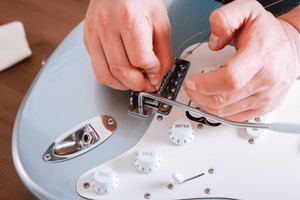
Does your guitar play and sound as good as when you first bought it? Over time various guitar parts can go out of adjustment or wear out. Or, maybe you bought a guitar, and it doesn’t play or sound right, even though it’s brand new. In this article, I’ll tell you how to set up an electric guitar so that it becomes your favorite axe and a “daily player.”
You don’t have to spend a fortune on a “custom shop” guitar to have it perform like one. Making a few adjustments or upgrades can make all the difference.
Keep reading to learn more; it’s easier than you probably think!
You can use the table of contents below to take you to the area that interests you. Click on the little box to open it and then click on the section of the article you want to read, or you can read from start to finish if you want the full guitar setup experience!
If you are in a hurry, click here to go directly to the setup procedure.
How Do You Know If Your Guitar Needs A Setup?

Is your guitar all it can be? If you’re experiencing a problem with your guitar, you most likely need to make an adjustment or do a “setup.” Maybe your strings are buzzing, or some notes are of out tune while others on the same string are not (an intonation problem).
A guitar setup is like a car tuneup. You systematically make routine adjustments and replace all the worn-out parts, like guitar strings. You clean and polish dirty areas along the way, like the guitar neck and frets.
Some guitars need to be adjusted or set up seasonally, while others require an adjustment to accommodate something like changing the string gauge.
It’s important to know what adjustments you can safely make to your guitar and which ones require more experience to avoid making things worse or damaging your instrument. See the section below on “Are You Qualified To Make Guitar Adjustments Or Modifications?”

Advantages Of Proper Setups
- Guitar is easier to play
- Strings stay in tune longer
- Notes are clear and sustain longer
- Prevents damage to the instrument

Poor Setup Problems
- Guitar is difficult to play
- Strings buzz
- Tuning and intonation problems
- May cause permanent damage to guitar

Setup Checklist
When you perform a setup, systematically check the following guitar parts.
- Tuners And String Trees
- Nut
- Strings
- Frets And Fingerboard
- Truss Rod
- Pickups
- Controls
- Bridge And Tremolo
Keep On Reading To Learn More About Each Topic
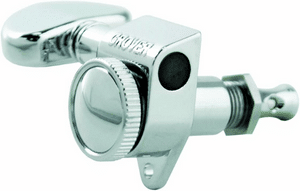
Tuners And String Trees
Your guitar’s tuning is only as good as its tuners (also called tuning machines or machine heads)!
Inspect each tuner to ensure they have not loosened from their attachment points on the headstock. You may need to tighten up the screws or nut that holds them in place, particularly as the wood ages. Do not overtighten them.
Guitars with cheap tuners and low gear ratios or tuning posts that “slip” when string tension is applied can make it difficult to tune the guitar or keep it tuned while playing, especially if you bend strings aggressively. Consider replacing them with better ones.
If your guitar has string trees (most guitars with locking tuners do not), clean and lubricate them when you change strings.

Nut
Closely inspect the guitar nut. Look for chips or cracks. Try to gently wiggle the neck to check for loosening.
Make sure that the strings are correctly seated in the nut slots. If the string gauge is too large for the nut, they will not seat themselves all the way down. The strings might wiggle from side to side if the gauge is too small.
The string gauge can cause tuning problems at the nut, especially if the guitar has a tremolo bridge without a locking nut. The nut may need to be adjusted, repaired, or replaced.
Non-locking nuts may require lubrication to keep the strings in tune while using the whammy bar. You can install a self-lubricating nut or use a nut lubricant like graphite (color in the nut slots with a pencil).
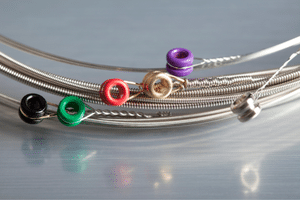
Strings
The type of strings you use is one of the major determinants of how your guitar will play and sound!
Brand name, string gauge, winding (round wound, half-wound, flat-wound, nylon-sound), and material type (nickel, steel, stainless steel, nylon) are all important considerations.
If you change the type of strings you use, the guitar will need to be re-evaluated for a setup. Going up or down 1 or 2 string gauge sizes will probably require a truss rod adjustment. Using stainless steel strings on a guitar with nickel frets will cause faster fret wear.
Clean your strings after playing the guitar and change them routinely. Dirty or worn-out strings are one of the most common causes of guitar problems. Always change your strings before you make any adjustments to your guitar to correct a problem like bad tone or string buzzing!
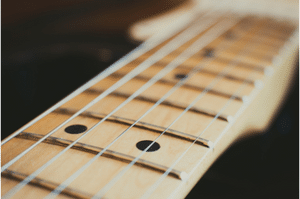
Frets And Fingerboard
It’s important to keep your frets and fingerboard clean. Dirty or worn-down frets can affect your tone and intonation.
After each string change, carefully inspect and clean your frets. You can use a neck cleaner that’s safe for the type of fingerboard wood you have. Some players use 0000 steel wool. Be careful not to scratch the fingerboard.
Most fret wire is made from nickel. Stainless steel frets last much longer. If you bend your strings frequently when you play, this will wear them down faster. From bending, old frets may have “dents” under the E, B, and G strings.
If your strings buzz at certain frets and your action and truss rod are adjusted correctly, they may need to be leveled and re-crowned or even replaced, which should be done by a professional.
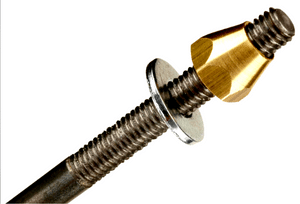
Truss Rod
It’s always a good idea to visually check the guitar neck relief while doing a guitar inspection or setup, especially if you’re getting string buzzing or the action seems off.
If you change to a thicker or thinner string gauge, the truss rod may need to be adjusted. Also, aging guitar necks may require adjusting as the wood dries out and shifts.
If you are not familiar with what a truss rod is or does, you can skip this step.
If you decide that the truss rod needs adjustment, do not attempt to reset the neck relief on your own unless you are familiar with the process. You could easily make things worse or permanently damage the guitar neck. Please bring it to a certified guitar technician instead for an evaluation.
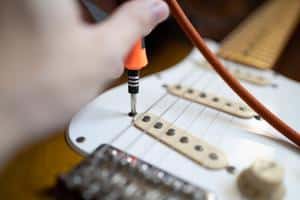
Pickups
The type, quality, and height of your pickups can significantly affect the tone and sustain of the notes you play.
Most decent guitars come with good pickups, which should be properly adjusted at the factory. If you change things like your string gauge or tremolo bridge angle, you might have to re-adjust one or more of your pickups.
Each pickup has its own “sweet spot,” in terms of distance from the top of the pickup to the bottom of the strings. Do not set your pickup height as high as possible to get more output volume. The proper height is determined by where the pickup sounds best. A pickup that is too close to the strings can also affect the guitar’s intonation in a negative way.
Consider using an overdrive pedal or a higher-gain amp if you want more “kick” out of your pickups.
If you love the way your guitar looks and plays but are not happy with the sound, always make sure everything is set up correctly before changing your pickups.
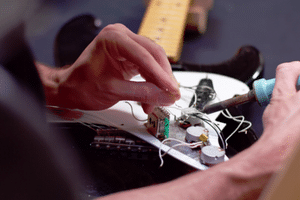
Controls
Keeping your electronic controls in good working condition will allow you to get the best sound and performance out of your pickups.
If you have a pickup selector switch (guitars with more than one pickup), check to ensure it works well in all positions. If it makes noise in your amp or your pickups cut out intermittently, it might need to be cleaned or replaced.
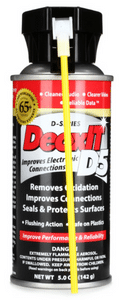
Volume and Tone Controls (Pots) that make a scratchy sound when you turn them or lose the pickup signal can also be dirty or worn out.
Never replace parts on a vintage guitar unless there is no other choice. It will decrease the value of the instrument. Keep the old parts in a safe place and include them with the guitar if you sell it.
The best way to clean dirty switches and pots is to remove built-up oxidation and dirt with a product like “Deoxit.”
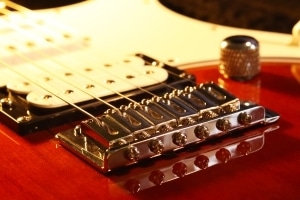
Bridge And Tremolo
Setting up your guitar bridge correctly is vital for getting the best sound from your guitar, especially if you have a tremolo bridge and use a whammy bar!
If the bridge saddles are not set at the proper height or distance from the nut, your guitar’s tuning and intonation could suffer.
When using a floating bridge (not flat against the guitar’s body), make sure that it returns to the proper position when you raise or lower it with the whammy bar.
If you use a whammy bar aggressively, you might be better off with a double-locking system (locks the strings at the bridge and the nut) to keep those “divebombs” from wreaking havoc with your tuning.

Beware Of String Gauge Changes!
If you change decide to go up or down in the size of your string gauge set, you will probably need to have your guitar set up to accommodate the change in string tension on the neck and bridge of the guitar.
This is one of the most common mistakes I see new players make.
So, if you are buying a guitar that comes with a 10-gauge string set and you want to play it with a set of 9-gauge strings, have the seller do the string change and then set up the guitar before you take it home!
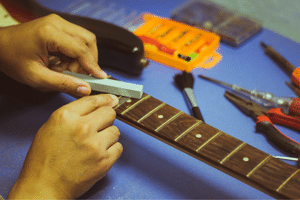
Are You Qualified To Make Guitar Adjustments Or Modifications?
It’s great to work on your guitars, especially if you have a lot of them, but you should always be aware of your limitations.
Adjusting things like an electric guitar’s string height (action) or pickup height can be straightforward. Still, some adjustments require the proper training and experience, like adjusting a guitar’s truss rod.
When you doubt your ability to adjust, repair, or modify your guitar, it’s always best to bring it to a competent guitar technician or luthier (guitar designer & builder). You can permanently damage your guitar, and it might never play and sound right again!
Making modifications to your guitar can void its manufacturer’s warranty and cause permanent damage to the instrument. Certain modifications are irreversible, so you may be stuck with them, even if you desperately want to restore the guitar to its original condition!
I learned that the hard way over the years until I did a three-year apprenticeship in a guitar repair shop. Now I have my own home workshop with the proper training and equipment to safely maintain and repair all my instruments.
Remember: “When In Doubt, Send It Out!”

Frequently Asked Questions
Here are some of the questions I get asked about setting up an electric guitar.
If your question does not appear here, please put it in the comments, and I will get right back to you with an answer.
Do New Electric Guitars Need To Be Set Up?
Most new electric guitars come set up properly from the factory, especially the more well-known brands. It’s important to note that the guitar is set up correctly for the string gauge it is pre-strung with.
Most solid-body electric guitars come with a 9-gauge string set. If you change the string gauge, it will affect your guitar’s setup.
Is It Hard To Set Up An Electric Guitar?
It’s not difficult to do the basic things, like adjusting the bridge saddles or pickup height, but your guitar could sound worse if you don’t know what you’re doing.
Can I Setup My Own Guitar?
Yes, many players set up their guitar, but it’s usually best to bring it to a certified guitar tech. If you are buying the guitar, ask the salesperson to include a free setup before you complete the purchase.
Never attempt to adjust the truss rod unless you have the proper training and experience, or you could permanently damage your guitar neck.
What Order Should I Set Up My Guitar?
I recommend you take a “top to bottom” approach to be thorough.
- Begin at the headstock and evaluate the tuning machines, string trees, and the nut.
- Next, check out the strings, frets, fingerboard, and neck relief.
- Move to the middle of the guitar to evaluate the pickups and controls.
- Complete the setup by looking at the bridge, bridge saddles, and tremolo parts (if applicable).
How Often Should You Set Up A Guitar?
Ideally, you should get a guitar setup with each change of season, due to the climate (temperature and humidity) change.
If you are transporting your guitar from one area to another in the same climate, like from a cold car to a warm room inside a club, wait about 20 minutes before playing to allow the guitar to acclimate to the proper temperature.
If your guitar is giving you a problem with tuning, intonation, or string buzzing, put on a new string set before doing or getting a setup. Remember, changing your sting gauge will probably require adjustments to the guitar.
So, if your guitar stops performing correctly and doesn’t need new strings, it probably needs a setup.

Final Thoughts
Your electric guitar should always be set up properly to avoid issues with tuning, intonation, and possible damage to the instrument. Learning basic setup skills is essential for any “do it yourself” player!
Clean your strings thoroughly after each time you play the guitar, including underneath, where the string meets the fret. Always keep a fresh set of strings in your case and change them as soon as the need arises.
Make it a habit to inspect and clean your guitar whenever you change strings. Adjust only what you feel comfortable doing if a setup is required and leave the rest to professionals.
If you change string set gauges, be aware that your guitar will most likely require a setup. Seasonal temperature and humidity changes can also necessitate a setup.

If your guitar won’t stay in tune, develops string buzzing, has intonation problems, or suffers a loss of tone, put on a new set of strings while cleaning the guitar and carefully inspecting it. If this does not solve the problem, you are most likely looking at a setup issue.

Tell Me What You Think
Please leave a comment below if you enjoyed this article, have any questions about how to set up a guitar, or want to give your point of view. I will be happy to help you.
- Do you set up your guitar(s)? Where did you learn to do it?
- What would you say is the most common cause of an electric guitar not playing or sounding right?
- Do you set up your guitar(s) with seasonal temperature and humidity changes?
- Has this article interested you in learning to do a guitar setup?



Thanks for this post on how to set up an electric guitar — it can be very helpful to playing proficiently.
When I was starting out and learning to play, I struggled to get the notes to ring clearly and usually chalked it up to being a beginner and being on the steep uphill side of the learning curve. While some of the sound was due to being a rookie, much of it was due to a poorly set up guitar that caused the strings to buzz whenever they were played. A good setup is key to playing well and hopefully, this article can save someone the same troubles I had!
Hi, Aly
Thank You for your comments!
A decent guitar that has been properly set up can make all the difference, especially to someone just starting to play! I had an experience very similar to yours as a beginner. It’s a very common scenario.
The first thing I did was try to lower the strings on my guitar as much as possible, which made things easier and more difficult simultaneously. I figured it was easy to drown out string buzz with a loud amp. 😊
Are you doing your own guitar setups at this point?
Frank
What a great article! I am one of those that didn’t start learning guitar until I was 40. I love the artistic look of nice guitars and thus have bought and displayed more than I actually play. That leads me to one of my questions – does it hurt a guitar to leave it unplayed with all the strings tight? I mean I’ll pull one off the wall, tune it up, play it a bit and then put it back up on the wall hanger for display and might not play that guitar for another year. Does that hurt the guitar in any way?
Also, I am in Las Vegas where we have very little, if any, humidity. I’ve heard that I need to worry about my guitars cracking or drying out. They are on display in my home office, a 25×35 foot room, with no direct sunlight on them. Is there anything I should be doing as they sit on the wall looking beautiful to make sure they don’t get ruined by low humidity?
Hi, Todd
Thank You for your comments and questions!
It’s great that you have your guitars hanging on the wall where you can enjoy looking at them, and they are conveniently available to play. I’ll answer your tuning question this way: “it depends.”
The effect of “storing” a guitar in standard tuning for up to one year is usually ok, especially for electric solid-body guitars in a normal temperature and humidity environment and without direct exposure to sunlight.
If the humidity is lower than normal, as you mentioned, you may need to run a humidifier in that room, especially if you have acoustic guitars.
Read the article on my website on “How To Store A Guitar – Avoid These Mistakes To Keep It Safe” for more info.
I keep all my guitars out on floor stands and at standard tuning, but I try to play a different one every several days.
I recommend you play your guitars more often and closely inspect them for signs of drying out and cracking.
Frank